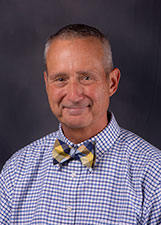When the Kent State campuses were closed in mid-March because of the COVID-19 quarantine, everything about teaching and learning had to change. On the Salem and East Liverpool campuses, the immediate concern was the students: how could we continue to deliver the academic content to them that they need to succeed?
Below are the thoughts of two well-respected faculty members from our Salem and East Liverpool campuses.


Dr. Rachael Blasiman is an associate professor of psychological sciences on the Salem Campus. Last fall, she received the Distinguished Teaching Award, the university’s most distinguished teaching award. She began teaching on the Salem Campus in 2010.
Dr. Dan Dankovich is a biology lecturer on the East Liverpool Campus, where he teaches human biology and anatomy/physiology. Last fall, he received the Outstanding Teaching Award, the highest honor for nontenure track faculty at the university. He has taught at Kent State since 2010 and has been a fulltime faculty member on the East Liverpool Campus since 2018.
Remote Teaching/Learning
Dr. Blasiman: “Teaching remotely is certainly a balancing act right now! As instructors, we want to provide our students with important information from the course, but also be flexible in responding to students' individual situations. We want to make sure they are getting a quality education and also consider that many of our students are struggling right now.”
Dr. Dankovich: “I am impressed by the way faculty and staff have taken on the challenge to take traditional face-to-face classes and make them work in this new setting. The dedication and commitment that I have witnessed from all faculty and the entire IT department that I have personally interacted with is an amazing example of ‘team.’ Everyone is trying their best and putting the needs of the students first. It is awesome to witness this from the inside.”
Students’ Response
Dr. Blasiman: “I see a wide variety of responses to moving classes online. Some of my students see it positively because it cuts down on driving time. They also like that they can view a recorded lecture multiple times to help with note-taking and studying. Other students are struggling with balancing school with family and work responsibilities, along with the general stress of being under quarantine and other health concerns.”
Dr. Dankovich: “My students seem fairly well prepared for this situation. I have communicated daily via email since the first day of this closing and now I email my students a minimum of three times per week. Continual communication and keeping them in the ‘loop’ has proven to be a great teaching strategy that makes them feel included and up-to-date with information. Maybe I have over-communicated, but I treat them like adults and told them every step along the way what was going on - good and bad! Several of them have commented that they appreciate this approach to include them in these always-changing times. I have had no withdrawals from either class and remote attendance is holding steady at over 95 percent!”
The Challenges

Dr. Blasiman: “My biggest challenge has been finding the time to set up classes online the way I want them to be! I have an ideal version of what I think an online class should look like and it's a challenge to match that to reality. I want my students' online experience to be positive, helpful, organized, easy to navigate, clear and adaptable to changing circumstances.”
Dr. Dankovich: “The biggest challenge that I have faced in adapting to this teaching style is the lack of hands-on learning and active learning in small groups in class and lab. I miss the hands-on dissections in lab and have sought additional ways to teach that. It has made me rethink and reevaluate my in-class time.”
The Positives

Dr. Blasiman: “I find that I'm more intentional in keeping up with my students as individuals. In class, these conversations arise organically, but moving online has made me more aware of how important it is to connect with people and find out about their lives and how their experiences intersect with their schoolwork.”
Dr. Dankovich: “I am now implementing new strategies that will make class and lab more interactive. These new strategies will continue once we return to face-to-face teaching to make class time even more interactive. Remote teaching has forced me to look honestly at my teaching style, how I deliver content and make changes that ultimately will help to further engage the student in, and with, the material.”
What do you miss most about the traditional classroom setting?
Dr. Blasiman: “The traditional classroom setting is dynamic and familiar; online teaching feels like uncharted territory. It requires new and creative ways of adapting course delivery, activities and assessments. It will take some time to adjust to a new routine, but I know we can do it!”
Dr. Dankovich: “No question - I miss the students. I believe that you form significant instructor-student relationships in the face-to-face setting. These are kids I have the opportunity to teach for two semesters and you cannot replace those daily interactions with the computer or a Zoom meeting. I am too attached to seeing them progress with the material and to the active learning that takes place in the live classroom. I especially love when the class goes off the rails and you take it in that ‘new’ direction. Learning is not a simple or a step-by-step clean process. I like when it gets messy. When there are questions. When the unexpected happens. I miss the spontaneity of face-to-face classes.”
Cutline A: Dr. Rachael Blasiman
Cutline B: Dr. Dan Dankovich
Cutline C: Dr. Dankovich interacting with students in his lab.
Cutline D: Dr. Rachael Blasiman in a traditional classroom setting.